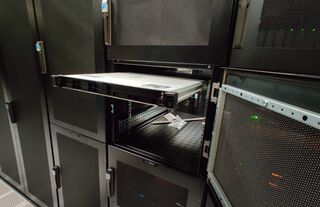Difference between revisions of "Machine/bender"
| (11 intermediate revisions by 2 users not shown) | |||
| Line 14: | Line 14: | ||
* 2TB NVMe SSD | * 2TB NVMe SSD | ||
* Ubuntu 20.04.2 LTS | * Ubuntu 20.04.2 LTS | ||
| + | |||
| + | [[Image:BenderRacked.jpg|thumb|320px]] | ||
== Info == | == Info == | ||
| Line 22: | Line 24: | ||
== Admins == | == Admins == | ||
| − | * [[User: | + | * [[User:MrBIOS|Alex Perez]], MrBIOS on #sugar Libera.chat IRC network |
| − | * [[User: | + | * [[User:Bernie|Bernie Innocenti]], bernie on #sugar Libera.chat IRC network |
| − | + | ||
| − | + | == Hosting == | |
| + | |||
| + | [[Image:SonicColo.jpg|thumb|320px]] | ||
| + | |||
| + | Hosted by Sonic in Santa Rosa CA | ||
== Network configuration == | == Network configuration == | ||
| − | + | Network configuration is managed via [https://netplan.io/ netplan]. To modify, do: | |
| − | |||
| − | + | vi /etc/netplan/bender.yaml | |
| − | + | netplan generate | |
| + | netplan apply | ||
| − | + | === IPv4 === | |
| − | |||
| − | |||
| − | |||
| − | + | Bender is globally accessible through a public, static IPv4 address. | |
| − | |||
| − | + | Sonic assigned a /28 network to Sugar Labs. IP assignments are managed in our DNS configuration. Search for "Sonico IP pool" in <code>masters/sugarlabs.org.zone</code>. | |
| − | + | === IPv6 === | |
| − | + | IPv6 configuration is a bit weird. | |
| − | + | * Public block: 2001:5a8:601:f::/64 | |
| − | + | * Sonic gateway: 2001:5a8:5:3a::15:0/127 | |
| − | + | * Transport IP: 2001:5a8:5:3a::15:1/127 | |
| − | + | ||
| − | + | The gateway is configured to route all traffic for our netblock to the transport IP, which is currently assigned to bender. | |
| − | + | ||
| − | + | === Bridges === | |
| − | + | The br0 bridge is created at startup and shared with the virtual machines hosted on Bender. It gives the VMs unfiltered access to the external network. There's no DHCP, all machines must define a static IP configuration, taking care not to stomp onto each other. | |
| − | + | ||
| − | + | There is also a virbr0 bridge created by libvirt on startup from <code>/etc/libvirt/qemu/networks/default.xml</code>. This is a NAT interface and is not meant for VMs directly serving on the Internet. | |
| − | |||
| − | |||
| − | |||
| − | |||
| − | |||
| − | |||
Guests simply need to be configured to accept IPv6 routing advertisements. The DNS must be assigned manually. | Guests simply need to be configured to accept IPv6 routing advertisements. The DNS must be assigned manually. | ||
| + | == Virtualization == | ||
| + | |||
| + | Virtual machines are KVM guests managed with libvirt. | ||
| + | |||
| + | === Storage === | ||
| + | |||
| + | All virtual disks come from a pool backed by the main LVM VG: | ||
| + | |||
| + | virsh # pool-define-as nvme-pool logical --source-name nvme-pool | ||
| + | Pool nvme-pool defined | ||
| + | |||
| + | virsh # pool-start nvme-pool | ||
| + | Pool nvme-pool started | ||
| + | |||
| + | virsh # pool-autostart nvme-pool | ||
| + | Pool nvme-pool marked as autostarted | ||
| + | |||
| + | virsh # pool-info nvme-pool | ||
| + | Name: nvme-pool | ||
| + | UUID: 5812819f-b8bf-484e-98fb-2e100fe83df2 | ||
| + | State: running | ||
| + | Persistent: yes | ||
| + | Autostart: yes | ||
| + | Capacity: 1.64 TiB | ||
| + | Allocation: 250.00 GiB | ||
| + | Available: 1.40 TiB | ||
| − | + | Disks assigned to VMs will appear here: | |
| − | |||
| − | + | virsh # vol-list nvme-pool | |
| − | + | Name Path | |
| + | ----------------------------------------- | ||
| + | aslo1-root /dev/nvme-pool/aslo1-root | ||
| + | aslo1-srv /dev/nvme-pool/aslo1-srv | ||
| + | backup /dev/nvme-pool/backup | ||
| − | + | Disks can be created, listed and deleted using the vol-* commands: | |
| − | + | virsh # vol-create-as nvme-pool testvm-root 20G | |
| + | Vol testvm-root created | ||
| + | |||
| + | virsh # vol-info testvm-root --pool nvme-pool | ||
| + | Name: testvm-root | ||
| + | Type: block | ||
| + | Capacity: 20.00 GiB | ||
| + | Allocation: 20.00 GiB | ||
| + | |||
| + | virsh # vol-delete testvm-root --pool nvme-pool | ||
| + | Vol testvm-root deleted | ||
| − | + | Please avoid allocating large VM volumes as image file within the host's root filesystem: they're slow and hard to manage. It's ok to use images for test VMs. | |
| − | |||
| − | |||
| − | |||
| − | |||
Revision as of 03:54, 31 July 2022
Hostnames
- bender.sugarlabs.org
Hardware
- HPE ProLiant DL360 Gen10 1RU server
- Dual socket, current configuration has one CPU
- Xeon Gold 5218R
- 20 cores/40 threads
- 2.1GHz base frequency, 4.0GHz max turbo frequency
- 27.5MB of cache
- 64GB RAM
- 2TB NVMe SSD
- Ubuntu 20.04.2 LTS
Info
Owned by Sugar Labs, Inc. Hosted by Sonic in Santa Rosa, CA
Bender and Papert are two twin KVM hosts bought by Sugar Labs in 2021.
Admins
- Alex Perez, MrBIOS on #sugar Libera.chat IRC network
- Bernie Innocenti, bernie on #sugar Libera.chat IRC network
Hosting
Hosted by Sonic in Santa Rosa CA
Network configuration
Network configuration is managed via netplan. To modify, do:
vi /etc/netplan/bender.yaml netplan generate netplan apply
IPv4
Bender is globally accessible through a public, static IPv4 address.
Sonic assigned a /28 network to Sugar Labs. IP assignments are managed in our DNS configuration. Search for "Sonico IP pool" in masters/sugarlabs.org.zone.
IPv6
IPv6 configuration is a bit weird.
* Public block: 2001:5a8:601:f::/64 * Sonic gateway: 2001:5a8:5:3a::15:0/127 * Transport IP: 2001:5a8:5:3a::15:1/127
The gateway is configured to route all traffic for our netblock to the transport IP, which is currently assigned to bender.
Bridges
The br0 bridge is created at startup and shared with the virtual machines hosted on Bender. It gives the VMs unfiltered access to the external network. There's no DHCP, all machines must define a static IP configuration, taking care not to stomp onto each other.
There is also a virbr0 bridge created by libvirt on startup from /etc/libvirt/qemu/networks/default.xml. This is a NAT interface and is not meant for VMs directly serving on the Internet.
Guests simply need to be configured to accept IPv6 routing advertisements. The DNS must be assigned manually.
Virtualization
Virtual machines are KVM guests managed with libvirt.
Storage
All virtual disks come from a pool backed by the main LVM VG:
virsh # pool-define-as nvme-pool logical --source-name nvme-pool Pool nvme-pool defined virsh # pool-start nvme-pool Pool nvme-pool started virsh # pool-autostart nvme-pool Pool nvme-pool marked as autostarted virsh # pool-info nvme-pool Name: nvme-pool UUID: 5812819f-b8bf-484e-98fb-2e100fe83df2 State: running Persistent: yes Autostart: yes Capacity: 1.64 TiB Allocation: 250.00 GiB Available: 1.40 TiB
Disks assigned to VMs will appear here:
virsh # vol-list nvme-pool Name Path ----------------------------------------- aslo1-root /dev/nvme-pool/aslo1-root aslo1-srv /dev/nvme-pool/aslo1-srv backup /dev/nvme-pool/backup
Disks can be created, listed and deleted using the vol-* commands:
virsh # vol-create-as nvme-pool testvm-root 20G Vol testvm-root created virsh # vol-info testvm-root --pool nvme-pool Name: testvm-root Type: block Capacity: 20.00 GiB Allocation: 20.00 GiB virsh # vol-delete testvm-root --pool nvme-pool Vol testvm-root deleted
Please avoid allocating large VM volumes as image file within the host's root filesystem: they're slow and hard to manage. It's ok to use images for test VMs.

